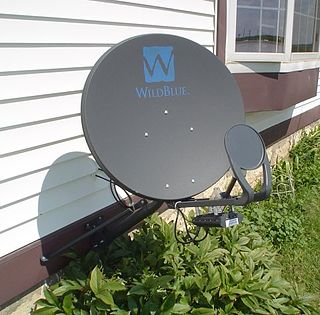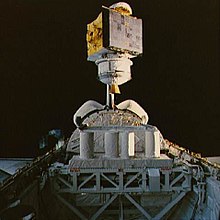
A communications satellite is an artificial satellite that relays and amplifies radio telecommunication signals via a transponder; it creates a communication channel between a source transmitter and a receiver at different locations on Earth. Communications satellites are used for television, telephone, radio, internet, and military applications. Many communications satellites are in geostationary orbit 22,236 miles (35,785 km) above the equator, so that the satellite appears stationary at the same point in the sky; therefore the satellite dish antennas of ground stations can be aimed permanently at that spot and do not have to move to track the satellite. Others form satellite constellations in low Earth orbit, where antennas on the ground have to follow the position of the satellites and switch between satellites frequently.

A very-small-aperture terminal (VSAT) is a two-way satellite ground station with a dish antenna that is smaller than 3.8 meters. The majority of VSAT antennas range from 75 cm to 1.2 m. Bit rates, in most cases, range from 4 kbit/s up to 16 Mbit/s. VSATs access satellites in geosynchronous orbit or geostationary orbit to relay data from small remote Earth stations (terminals) to other terminals or master Earth station "hubs".

Satellite Internet access is Internet access provided through communication satellites; if it can sustain high speeds, it is termed satellite broadband. Modern consumer grade satellite Internet service is typically provided to individual users through geostationary satellites that can offer relatively high data speeds, with newer satellites using the Ku band to achieve downstream data speeds up to 506 Mbit/s. In addition, new satellite internet constellations are being developed in low-earth orbit to enable low-latency internet access from space.

Westar 1 was America's first domestic and commercially launched geostationary communications satellite, launched by Western Union (WU) and NASA on April 13, 1974. It was built by Hughes for Western Union, using the HS-333 platform of spin-stabilized satellites. It operated until May 1983.
Westar was a fleet of geosynchronous communications satellites operating in the C band which were launched by Western Union from 1974 to 1984. There were seven Westar satellites in all, with five of them launched and operating under the Westar name.
SES World Skies was a short lived company formed as a result of the merger between the two SES subsidiaries, SES Americom and SES New Skies. The company was merged into its parent company, SES in 2011.

SES S.A. is a Luxembourgish satellite telecommunications network provider supplying video and data connectivity worldwide to broadcasters, content and internet service providers, mobile and fixed network operators, governments and institutions.
SES Americom was a major commercial satellite operator of North American geosynchronous satellites based in the United States. The company started as RCA Americom in 1975 before being bought by General Electric in 1986 and then later acquired by SES in 2001. In September 2009, SES Americom and SES New Skies merged into SES World Skies.
Astra 1B was the second of the Astra communications satellites launched and operated by SES to add extra capacity to the satellite television services from 19.2° East, serving Germany, the United Kingdom and Ireland.

Satellite television is a service that delivers television programming to viewers by relaying it from a communications satellite orbiting the Earth directly to the viewer's location. The signals are received via an outdoor parabolic antenna commonly referred to as a satellite dish and a low-noise block downconverter.

The Wideband Global SATCOM system (WGS) is a high capacity United States Space Force satellite communications system planned for use in partnership by the United States Department of Defense (DoD), Canadian Department of National Defence (DND) and the Australian Department of Defence. The system is composed of the Space Segment satellites, the Terminal Segment users and the Control Segment operators.
AMC-11 , previously GE-11, is an American geostationary communications satellite which is operated by SES S.A. It is currently positioned in geostationary orbit at a longitude of 131° West, from where it is used to relay cable television across North America for onward distribution. It broadcasts to Canada, the Caribbean, Mexico and the United States.
AMC-4 is a commercial broadcast communications satellite owned by SES World Skies, part of SES S.A.. Launched in 1999, from Centre Spatial Guyanais, ELA-2 by Ariane 44LP H10-3. It provides coverage to North America, Latin America, Caribbean. Located in a geostationary orbit, AMC-4 provides service to commercial and government customers, with programming distribution, satellite news gathering and broadcast internet capabilities.

USA-195, or Wideband Global SATCOM 1 (WGS-1) is a United States military communications satellite operated by the United States Air Force as part of the Wideband Global SATCOM programme. Launched in 2007, it was the first WGS satellite to reach orbit. It is stationed at a longitude of 174.8° East.

The Military Satellite Communications Directorate is a United States Space Force organization headquartered at Los Angeles Air Force Base, California. It is one of several wings and other units that make up the Space and Missile Systems Center (SMC).
Astra 5A was one of the Astra communications satellites owned and operated by SES at the Astra 31.5°E. Launched in 1997 to the 5° East position by NSAB as Sirius 2, operation of the satellite was transferred to SES in April 2008 and the craft renamed and moved to 31.5° East to open up a new orbital position for the company for the development of markets in Central and Eastern Europe and the Middle East.

AMC-8, also known as Aurora III, previously GE-8, is a C-band satellite located at 139° West, covering the United States, Canada and the Caribbean. It is owned and operated by SES World Skies, formerly SES Americom and before that GE Americom. The satellite provides critical telecommunications services to AT&T Alascom, which occupies most of the satellite's capacity. AMC-8 was launched in 2000 as GE-8, and replaced Satcom-C5 in March 2001.

USA-204, or Wideband Global SATCOM 2 (WGS-2) is a United States military communications satellite which is operated by the United States Air Force as part of the Wideband Global SATCOM programme. Launched in 2009, it was the second WGS satellite to reach orbit, and operates in geostationary orbit at a longitude of 60° East.

USA-244, or Wideband Global SATCOM 6 (WGS-6) is a United States military communications satellite operated by the United States Air Force as part of the Wideband Global SATCOM programme. Launched in 2013, it was the sixth WGS satellite to reach orbit. It is stationed at a longitude of 135° West, in geostationary orbit. WGS-6 was procured by the Australian Defence Force for the U.S. Air Force, in exchange for participation in the programme.
Intelsat K was a geostationary communication satellite built by Lockheed Martin. It was located at orbital position of 21.5 degrees west longitude and was owned by SES World Skies. The satellite was based on the AS-5000 platform and its life expectancy was 10 years. It was retired from service in August 2002 and transferred to a graveyard orbit.











